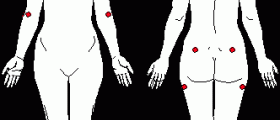
What is fibromyalgia?
Pain all over the body that renders the sufferer disabled, stiffness and tenderness in joints, muscles, tendons, and most commonly experienced by women between the age of 35 and 55. These are typical symptoms of fibromyalgia. Although fibromyalgia is one of the most common muscle problems, there are paradoxically few doctors who know their fibromyalgia and it can take time, painful and painfully long time to get proper diagnose.
Are then such doctors to be charged with not having a clue? Well, maybe not. Cause for fibromyalgia is still a mystery. There are no usual suspects. There is no inflammation, no joint damage, no damage to internal organs. It is therefore defined as a syndrome, as it is identifies with a number of symptoms.
Symptoms
A number of symptoms can be associated with fibromyalgia. Among these are morning stiffness, headaches, difficulty concentrating, skin sensitivities, severe fatigue, anxiety, depression, chronic muscle pain, muscle spasms or leg cramps, sleep problems, irritability, intestinal problems. Now, that surely is a long list and it should not be so troublesome to identify condition as fibromyalgia by these symptoms, right? Of course, except for the fact that these symptoms are also indicative of disorders such as degenerative joint disease, chronic fatigue syndrome, irritable bowel syndrome, liver disease, lupus, Lyme disease, thyroid dysfunction, heart disease, arthritis and then some.
Development
To add to the mystery, there is no pattern in offset. You are just having some pain, as by bruising, but it never wears off or fades away. Onset is gradual, and pain becomes more severe as time passes. Pain levels eventually become so high that they impede normal life. It seems that fibromyalgia is of hereditary nature.
Mechanism and consequences
Fibromyalgia can be defined as inability of body to process and regulate pain in a regular way. In this condition, nerves all over the body become super-sensitive and even regular, otherwise unnoticed sensations of pain and discomfort can scream agony through such overly sensitive nerves all day long. Pain levels felt by affected persons range from mild to incapacitating, and pain is more pronounced in rest than during physical activity.
There is also problem with hormones such as adrenaline and epinephrine, related to "fight or flight" self-preservation mechanism which are released during sleep in response to feeling of pain and discomfort (while awake, brain maintains a threshold on these sensations, but not in 'full auto' mode) and prevents deep, restoring and relaxing sleep, keeping the body at constant alert instead of letting it heal and restore.








-vs-Trigger-Points-(Myofascial-Pain-Syndrome)_f_280x120.jpg)








Your thoughts on this
Loading...